Tue 18 May 2021
The F/X Movies, Reviewed by David Friend.
Posted by Steve under Action Adventure movies , Reviews[5] Comments
Reviewed by David Friend
Just over a year ago saw the passing of American Golden Globe-winning actor Brian Dennehy, best known for his roles in Rambo: First Blood, Cocoon, Romeo + Juliet and the two fondly remembered F/X action thrillers. In a weird coincidence, I had only seen this pair a couple of weeks previously – they had passed me by for years – and this may be a good excuse as any to share the love.
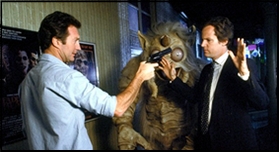
The first film, 1986’s F/X: Murder By Illusion, was a hit at the box office and went on to become the biggest-selling film in video rentals. Critics loved it too, including Roger Ebert, and it now enjoys an impressive 88% rating on Rotten Tomatoes. It was followed by a sequel and a short-lived television version, while a remake has been in the offing for the last decade. So, keen to see what I’d been missing out on, I set the DVD and waited to be impressed. And colour me thus.
Hunky Australian Roland “Rollie” Tyler (Bryan Brown) works in the American film industry as a special effects artist. You should see his flat. It’s full of alabaster heads and mannequins that look like murdered spouses. He’s so good at his job, in fact, that Department of Justice agent Martin Lipton (Cliff DeYoung) wants his help in faking the murder of a mob informant named Nicholas DeFranco (ironically, Law and Order’s Jerry Orbach), before the mafia do it for real.
Rollie reluctantly accepts the assignment, fixes DeFranco up with fake blood packs and even gets talked into playing the killer by head honcho Edward Mason (Mason Adams). The staged hit at an expensive Italian restaurant goes as planned and Rollie believes his part is over – until Lipton tries to kill him as a “loose endâ€. Rollie escapes, but as more blood is spilled – the real stuff, this time – he is forced to confront a conspiracy which involves some very corrupt lawman and many millions of dollars.
Fortunately, Rollie is resourceful, with a career’s worth of Tinseltown trickery to surprise and snare his murderous pursuers. Meanwhile, middle-aged maverick homicide detective Lt. Leo McCarthy (Dennehy) becomes suspicious of DeFranco’s supposed death, but his investigation is frustrated by senior officials who have the power to keep their secrets buried – along with anyone who gets too interested.

Although somewhat hampered by an enigmatic title, the film has a shrewd, playful script and a convincing turn from purse-lipped Bryan Brown, here caught between his breakout role in the Australian mini-series A Town Like Alice and Tom Cruise’s bottle-juggling juggernaut Cocktail (also, somewhat less illustriously, a supporting role in the vacuous Paul McCartney vehicle Give My Regards to Broad Street).
Early on, his ineffective flailing with a wily sniper demonstrates just how alien Rollie is in a world of cold kills and glibly indifferent corruptors, yet his ingenuity with practical illusions quickly evens the odds, and it’s then that the film goes from a conventionally Hitchcockian man-on-the-run thriller to one which is confident enough to throw some black comedy and charismatic character business among the squealing car chases.
Rollie is an everyman, and confident in his abilities, yet the script doesn’t bother explaining the specifics of his armoury, but instead lets him deploy each trap – which is what they manifestly become, original usage be damned – to the gleeful surprise of the audience.
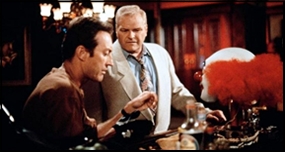
Running alongside all this is the police investigation, coloured by Dennehy’s roguishly charming renegade, but anyone hoping that these two characters will meet and spar will be disappointed as the threads don’t link up until the end. As such, the narrative may risk becoming disjointed yet avoids it, more or less, by slowly explaining the mayhem which Rollie is experiencing elsewhere. This makes it different from, say, The Fugitive, which gave us lawmen searching obsessively for our hero, and North By Northwest, which omitted the chase entirely.
The film isn’t without its flaws, however. Although there are some charming scenes between a gently flirtatious McCarthy and savvy computer geek Marisa Velez (Jossie DeGuzman), a couple of other promising characters are perfunctorily dropped, including a guileless sergeant (amusingly played by Joe Grifasi) and original antagonist Lipton.
More awkwardness is found at the climax. At first, it’s handled well, with yet more slickly mischievous pyrotechnics, and the main bad guy is disposed of in a particularly clever way, yet we’re afforded an unnecessary postscript which robs the story of a satisfying, slam-dunk conclusion.
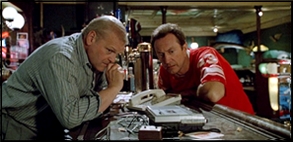
The sequel, 1991’s F/X: The Deadly Art of Illusion, wasn’t as well received, but there’s still plenty to enjoy and in some ways it’s better than the first. I love sequels (it’s even my favourite word) as it means we get to spend more time with characters we like, and this time they do too, sparing together like they couldn’t before.
The plot again sees Rollie enlisted to work his movie magic on a police sting, one involving a rapist who has served time in prison yet is too dangerous to remain free. Things go wrong, of course, and, as before, Rollie discovers it was an inside job, the bad guys want him dead and he relies on his technological know-how and smart survival tactics to stay alive.
The recipe, then, is largely the same, but with a couple of new ingredients. There’s a scheme involving antique gold medallions crafted by Michelangelo which is very National Treasure, and a couple of truly novel action sequences, most memorably a chase around a supermarket in which baked beans prove every bit as dangerous as natural uranium, and a surreal yet surprisingly exciting fight against an imitative robot clown.
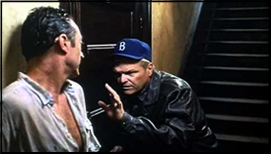
However, in giving the hero a distinctly technological approach to combat, as opposed to letting him use his fists (perhaps he’s a pacifist, but what this man can do with an aerosol spray would impress MacGyver), the script forces him to do this every time. At one point, instead of simply bonking some henchmen over the head, we’re expected to believe he has previously infiltrated the villain’s heavily-guarded house in order to set traps which shall enable him to infiltrate it again.
It’s a paradox worthy of Steven Moffat-era Doctor Who. Of course, that’s the nature of the beast, and writer Bill Condon (future Oscar winner of such impressively diverse films as Chicago, Mr Holmes, the last two Twilight films, Kinsey and The Greatest Showman) does all he can to keep it roaring. By the end of this sequel, the premise may seem a little tired, but it’s a solid one nonetheless, with both films playing out like an adult, city-wide Home Alone, somehow balancing psychological realism with a wry sense of humour. And, like most of Rollie’s gadgets, it makes for a neat trick.
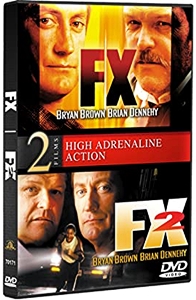
May 18th, 2021 at 7:44 pm
I didn’t like the sequel quite as much, but over all my feelings about this are close to those expressed here. It is a pleasant memory, somewhat smarter than it has to be, and still has some charm and inventiveness to deliver. If not a classic it’s a near classic.
May 18th, 2021 at 9:33 pm
I missed both of these when they first came out, alas. I’ll have to check online if/where they might be playing.
Brian Dennehy, who made a couple hundred movies besides this one, was always a favorite of mine, which makes me all the more puzzled as to why these slipped right on by.
May 19th, 2021 at 9:01 am
Dennehy made a half-dozen TV movies in the ’90s that were fictionalised accounts of an Illinois cop named Jack Reed. I’ve got one of them but have yet to see it. Anyone recommend them?
May 19th, 2021 at 12:01 pm
I enjoyed the one I remember watching, but in all honesty I don’t know which one it was. I didn’t even know how many there were. Here’s a list:
The series includes the TV films:
1992: Deadly Matrimony directed by John Korty
1993: Jack Reed: Badge of Honor directed by Kevin Connor
1994: Jack Reed: A Search for Justice directed by Brian Dennehy
1995: Jack Reed: One of Our Own directed by Brian Dennehy
1996: Jack Reed: A Killer Among Us directed by Brian Dennehy
1996: Jack Reed: Death and Vengeance directed by Brian Dennehy
May 19th, 2021 at 3:12 pm
Thanks, Steve. I must check these out.